and the distribution of digital products.
State of Rootstock Q2 2024
- New daily verified contracts reached all-time highs with 34. Rootstock had its highest-ever number of new contracts verified in a day this quarter, peaking in June.
- Rootstock announced over 20 partnerships and collaborations this quarter with projects such as SushiSwap, OpenOcean, Footprint Analytics, and Galxe.
- DeFi TVL remained steady in Q2. DeFi consolidated on the Rootstock sidechain as it declined 17.7% QoQ.
- Merged mining hashrate on Rootstock achieved 61.5% in Q2. Rootstock continued to show strength in security by leveraging over 61.5% of the hashrate from Bitcoin to secure its network and marking it as the “Mature Phase” for Rootstock.
- RootstockLabs announced the BitVMX framework. This framework laid the groundwork for building decentralized, trust-minimized, and permissionless bridges, a crucial step toward increasing network decentralization and functionality.
Rootstock is a permissionless Bitcoin sidechain launched on mainnet in January 2018. It aims to bring smart contract functionality to the Bitcoin network. It does not have its unique native token, instead using BTC in the form of “Smart Bitcoin” (RBTC), which maintains a two-way peg to Bitcoin. RBTC is a bridged BTC version that is used for gas fees on Rootstock. It allows owners to interact with DeFi protocols and dapps on the Rootstock network for minting, swaps, and more. RBTC uses a bridging system called Powpeg that connects Bitcoin and Rootstock.
To secure its network, Rootstock uses merged mining and DECOR+ (Deterministic Conflict Resolution) consensus, a Proof-of-Work (PoW) protocol that maintains the Bitcoin block format.
Rootstock has several additional components. Rootstock Virtual Machine (RVM) is a forked version of the Ethereum Virtual Machine (EVM) that allows for high compatibility with EVM. Rootstock also features RIF (Rootstock Infrastructure Framework), a comprehensive suite of blockchain-based infrastructure services such as RIF Token, RIF Wallet, RBTC Flyover, RNS (RIF Name Service), and RIF Relay. RIF is also used as the governance token for the RootstockCollective DAO. For a complete primer on Rootstock, refer to our Initiation of Coverage report.
Website / X (Twitter) / Telegram
Key Metrics Financial Analysis
Financial Analysis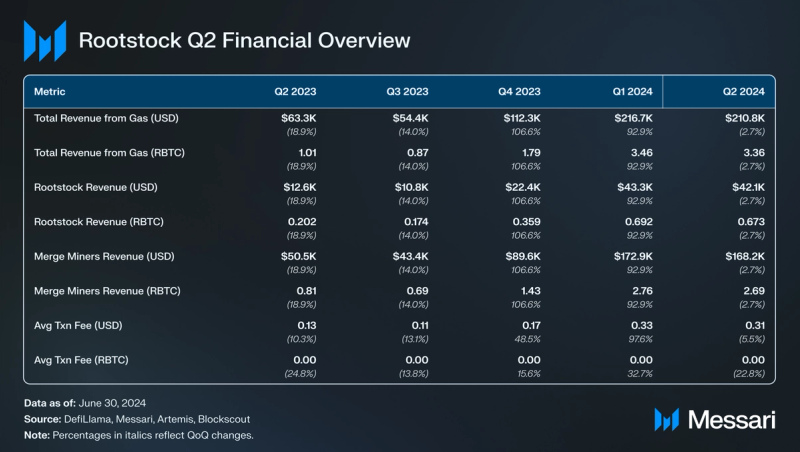
Rootstock’s native asset is BTC in the form of RBTC, a 1:1 representation of BTC that is locked on the Bitcoin network and is mirrored on the Rootstock sidechain. The platform generates revenue through transaction fees, which are divided as follows:
- 0.8% to the Powpeg Federation.
- 20% to RootstockLabs.
- 79.2% to the block producers, which are miners and mining pools.
Rootstock’s revenue performed strongly by increasing 92.9% QoQ in Q1 and remained steady, only experiencing a 2.7% decrease in QoQ revenue for Q2 despite greater consolidation across the DeFi ecosystem. The stability could be pointing at a strong underlying user base as well as desirable miner mechanisms such as merged mining. For example, Bitcoin miners can increase their revenue without having to increase any computational power and subsequent costs.
Network Analysis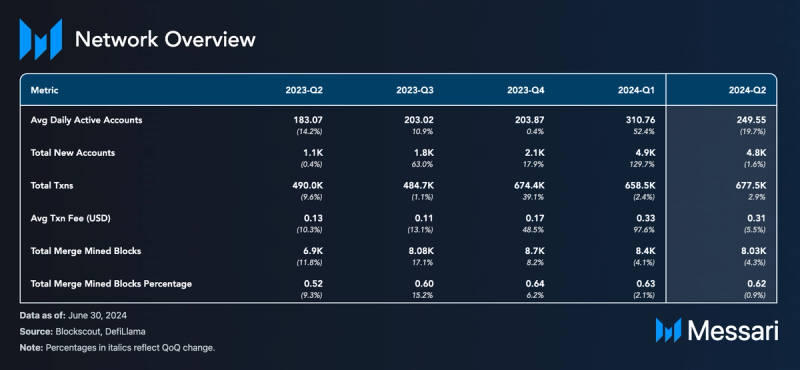
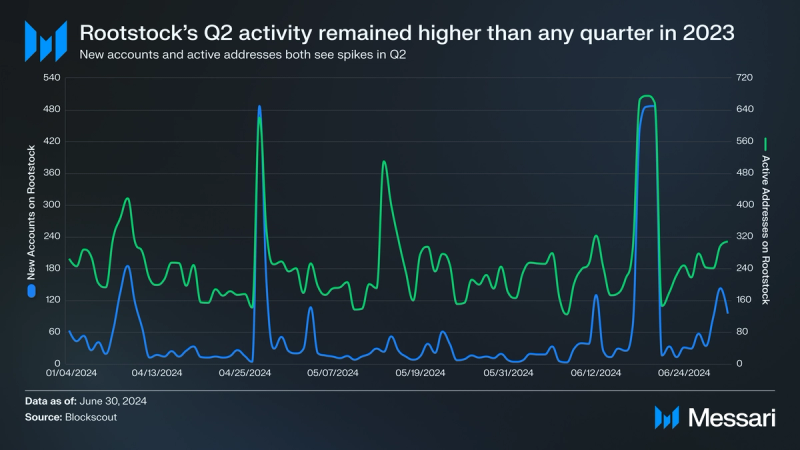
In Q2, Rootstock saw significant spikes in new accounts, driven by its efforts to expand the ecosystem. RootstockLabs and other ecosystem contributors actively onboarded more protocols to the network, namely Galxe and SushiSwap. While Rootstock had a strong Q1 of 2024, it was likely due to the start of the latest wave of the RootstockLabs grants program on top of that we saw renewed interest in staking and lending BTC in protocols such as Sushi and Money on Chain. The activity on Rootstock during Q2 reduced by 19.7% as far as average daily active accounts. Despite the reduction, Q2’s activity remained higher than any of the final three quarters in 2023. The RootstockLabs team has continued to foster partnerships to offer more services to users, which should continue to increase active accounts.
The total transactions in Q2 increased slightly by 2.9%. Over the last three quarters, this metric has stayed consistent, ranging between 658,000 transactions and 677,000, despite the average transaction fee (USD) increasing by 82% since Q4 2023. This fee increase was heavily correlated with the increase in BTC (and subsequently RBTC) over the past three quarters. The stability in total transactions indicates user resilience and network stability, showing that users continue to find value in the network even as costs rise.
In Q2 2024, the average total merge mined blocks percentage was 61.5%. So long as this metric is above Rootstock's “critical hash rate” threshold of 60%, the network experiences security and stability. This concept is explained further in the Development Activity section.
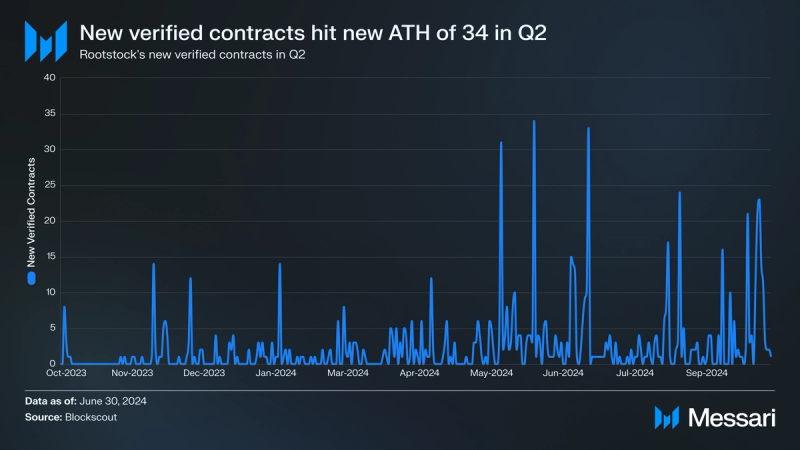
In Q2, Rootstock reached new highs in average daily verified contracts on the network, hitting a daily record of 34 on June 7, 2024. This milestone demonstrates the ongoing growth in onchain activity as Rootstock’s ecosystem strengthens.
Ecosystem Overview
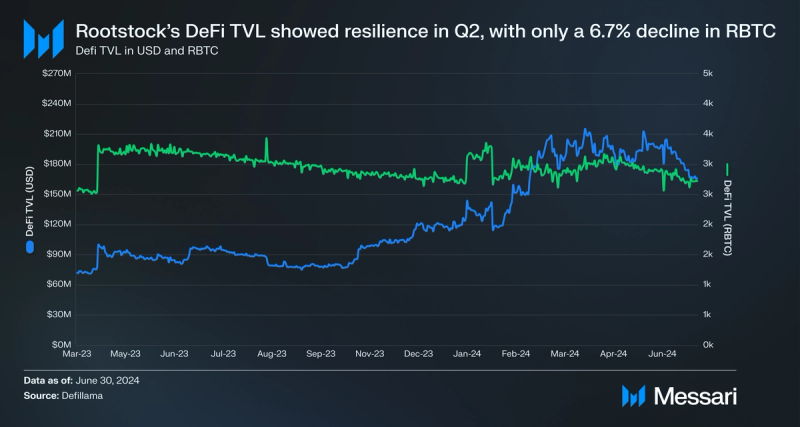
Overall, DeFi TVL on Rootstock consolidated in Q2 from the highs it reached in Q1. While Rootstock had a leap in Q1 up 73.6% QoQ, Rootstock experienced a period of consolidation declining 17.7% QoQ in Q2. Despite weaker market conditions in Q2, Rootstock’s DeFi TVL showed resilience, declining only marginally compared to its QoQ gain in Q1. As Rootstock continues to onboard more projects and protocols, the ecosystem is positioned for future growth and strengthened service for its users. While the DeFi TVL value in USD fell 17.7%, the TVL in RBTC decreased by a mere 6.7%.
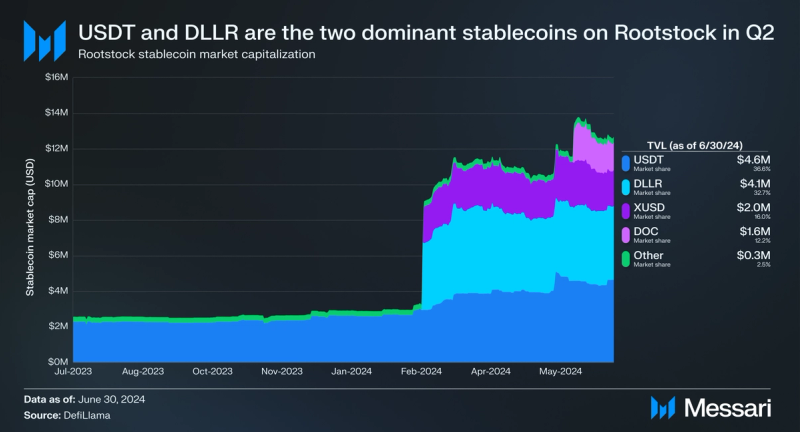
As of Q2, USDT controlled over 36.6% of the total stablecoin supply on Rootstock, with DLLR, Sovryn protocol’s stablecoin, following closely at 32.7%. Rootstock’s stablecoin ecosystem remained diverse, with no single stablecoin reaching above 50%. This variety gives users multiple options when interacting with protocols.
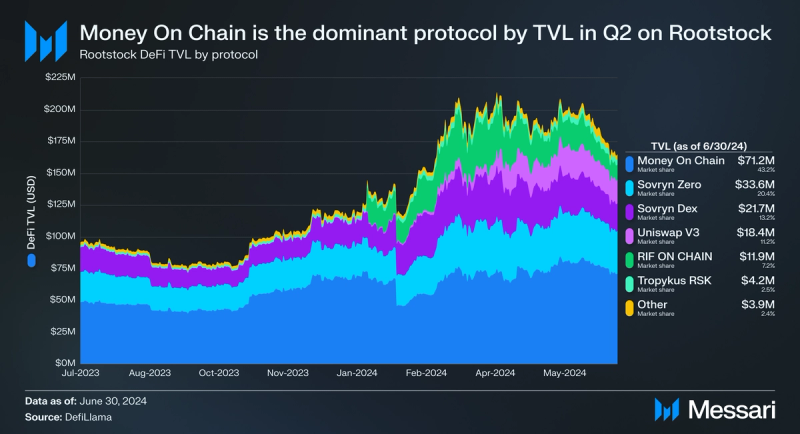
In Q2, Money On Chain maintained its position as the dominant protocol by TVL on Rootstock, with a 43% market share. It provides various services, acting as a Bitcoin-collateralized protocol and offering its Bitcoin-backed stablecoin.
A standout development in Q2 has been the rapid growth of Uniswap on Rootstock, starting the quarter out with only 3.0% of the DeFi TVL market share and finishing the quarter with 11.2%. Uniswap made significant strides on the network, quickly accumulating a TVL of $18.4 million.
The biggest reduction in market share was experienced by RIF ON CHAIN. At the beginning of the quarter, it had a market share of 18.5%, which reduced to 7.2% by the end of Q2, with $11.9 million locked into the protocol.
PartnershipsIn Q2, Rootstock expanded offerings in its ecosystem and RootstockLabs announced over 20 official collaborations. The main focus of these were bridging protocols and DEX-aggregators. Many of Rootstock’s new network contributors offer a simplified path for users to bridge on or off the Rootstock L2 ecosystem, significantly increasing their accessibility to the greater DeFi space, especially with EVM-based protocols. These newer teams on Rootstock also offer services such as NFT aggregators, oracles, and perpetual trading platforms. The most significant additions to Rootstock in Q2 are outlined below.
Bridges, DEXs, and DEX-aggregators:- Rubic: A cross-chain aggregator that simplifies DeFi by connecting 80+ blockchains and supporting 15,500+ crypto assets for efficient swaps. It provides users with the best rates, liquidity, and transaction speeds, enabling seamless movement of assets across different networks.
- OpenOcean: A leading DEX aggregator that sources liquidity from multiple decentralized exchanges, offering users the best returns for crypto trading. OpenOcean’s cross-chain swaps also allow the seamless transfer of assets across multiple chains.
- SushiSwap: A leading multichain DEX with cross-chain swaps and advanced trading solutions, operating on over 30 blockchains, including RSK.
- Woodswap: A DEX built on Rootstock with features such as the Discretized Liquidity Automated Market Maker (DLAMM) mechanism that maximizes liquidity efficiency and reduces slippage for swaps and introduces liquidity mining to improve yields.
- Portal Finance: A decentralized, trust-minimized platform enabling peer-to-peer native swaps across multiple blockchains without relying on wrappers, bridges, or custodial exchanges. It offers a secure and intuitive experience with minimal slippage, designed to integrate easily with blockchains, DEXs, and wallets.
- Jumper Exchange: A DEX that lets users swap any token onchain using any bridge and decentralized exchange supported by the platform (22 chains routed through 30 DEX/DEX-aggregators).
- ChainPort: ChainPort is a permissionless and fully custodian bridge that lets users port any crypto token (ERC-20 native and Polygon native) to different blockchains.
- Rehold: A multichain DeFi protocol enabling trading, earning, and swapping across Bitcoin and EVM networks. It utilizes Constant Liquidity Market Makers (CLMMs) to offer high-yield, short-term investments with cryptocurrencies.
- Artoshi: One of the first NFTs built on the Bitcoin network using Layer-2 technology, combining Bitcoin’s security with smart contract versatility. Artoshi aims to be the leading platform for Bitcoin NFTs, providing a smooth and scalable NFT experience.
- Etherspot: A multichain development platform that leverages account abstraction to simplify user experiences in Web3 applications. It integrates advanced features like gasless transactions and flexible wallet management, providing seamless onboarding and improved interactions for dApps, EVM-compatible rollups, and L1/L2 chains.
- Dega: Builds tools that simplify and speed up the development of Web3 games and Metaverse products. Their partnership with Rootstock enables onchain map publishing, making game creation easier for everyone.
- Umbrella Network: A decentralized oracle service providing secure, scalable, and customizable data solutions for blockchain projects. It offers smart contracts real-time data feeds, from crypto prices to sports data, secured by decentralized validators.
- Galxe Quest: A leading platform for building Web3 communities through reward-based loyalty programs. Galxe offers a no-code solution for creating engaging campaigns and distributing rewards, now available on the Rootstock chain. Trusted by major players like Optimism and Arbitrum, it connects projects with millions of users.
- Kartel: A decentralized derivatives trading platform built on the Bitcoin ecosystem, offering orderbook-based trading with 50+ pairs and up to 20x leverage, powered by Arbitrum and EigenLayer.
- Footprint Analytics: A platform that provides tools to analyze and visualize blockchain data across 30+ networks easily. It helps users create charts and dashboards for insights on NFTs, GameFi, and transactions, without needing coding skills.
In May 2024, core contributors to Rootstock unveiled its roadmap for the upcoming year, outlining significant proposals for improvement planned for the next four quarters. The goals are categorized by quarter, each with a distinct theme:
- Q2 2024 - The Revelation Phase
- Q3 2024 - The Advancement Phase
- Q4 2024 - The Scaling Phase
- Q1 2025 - The Decentralization 2.0 Phase
Within each of these themes are a number of RSKIPs (Rootstock Improvement Proposals) which are now being considered for inclusion by the community. In Q2 2024, RootstockLabs introduced the BitVMX framework, a new open-source project from RootstockLabs and Fairgate Labs designed as a virtual CPU to verify arbitrary programs on the Bitcoin blockchain. BitVMX aims to allow sophisticated computations on Bitcoin without requiring significant infrastructure changes or hard forks. This framework lays the groundwork for building decentralized bridges, a crucial step toward increasing network decentralization and functionality.
Throughout Q3 and Q4 of 2024, Rootstock’s core contributors will focus on the Advancement and Scaling phases. In Q3 2024, Rootstock will work to improve the network by creating a better bridging experience for users. The Rootstock Lovell Network Upgrade will enhance the network’s security and efficiency by optimizing the Powpeg protocol and introducing new VM opcodes. These features will increase Ethereum compatibility and expand the range of decentralized applications that can seamlessly operate on Rootstock. Additionally, the integration of the Lightning Network will simplify the peg-in and peg-out process, allowing for faster and more flexible Bitcoin transfers. With this integration, users will be able to select their preferred method for entering Rootstock. Finally, there are plans to implement a Bitcoin Native Assets Bridge, that allows Bitcoin assets (Runes/Taproot Assets) to freely flow between the Bitcoin mainchain and Rootstock.
Rootstock’s plans to increase accessibility to users by leveraging integrations with Boltz Exchange and the RIF Flyover protocol. The upgrade with Boltz Exchange aims to simplify and speed up non-custodial BTC mainchain, Liquid Bitcoin and LN-BTC swaps on Rootstock, making transactions faster and more cost-effective.
The Flyover integration improves users' experience when swapping RBTC for BTC, offering frictionless native BTC/RBTC transfers within Rootstock’s peg web decentralized app (dapp). The integration works by introducing a liquidity provider (trustless intermediary) that advances funds to the user while the Powpeg protocol settles their bridging transaction.
For example, if a user wants to convert BTC to RBTC, they would send their BTC to the Powpeg address provided by the Flyover protocol. Then, the intermediary would advance the equivalent amount of RBTC to the user, and the user’s BTC would remain in the Flyover smart contract (Liquidity Bridge Contract - LBC) until Powpeg has validated the transfer.
Currently, four types of bridges are available for Bitcoin-to-Rootstock conversions: 1) Powpeg, 2) Sovryn’s FastBTC, 3) CEXs, and 4) Third party applications such as Router, Elk and oooo.money. While viable, these solutions have limitations—for instance, Powpeg has long settlement times, and CEXs require full custody of assets, exposing them to potential risks like hacks or funds being frozen for lengthy periods.
Overall, this swap is much faster than the current Powpeg process, taking about 12 minutes versus the current Powpeg model which takes about 16 hours to convert BTC to RBTC and about 33 hours for RBTC back to BTC. The Flyover protocol is all being done without the liquidity provider ever having custody or access to users’ funds.
This upgrade benefits multiple stakeholders. Developers building DeFi protocols on Rootstock can integrate Flyover to reduce user entry barriers. Users holding Bitcoin in cold wallets or on exchanges can engage with Rootstock’s DeFi ecosystem and return to Bitcoin within minutes, without compromising security. Additionally, liquidity providers can generate revenue by earning service fees for facilitating RBTC-to-BTC swaps.
In Q4 2024, Rootstock’s proposed roadmap is focused on achieving faster and more cost-effective transactions, encouraging the development of scalable products and dApps. Contributors to the network plan to achieve this through three main upgrades.
- The RSKj Snap Synchronization will introduce a new synchronization mode, allowing Rootstock nodes to sync in only a few hours, improving the overall network efficiency and reducing the time required for new nodes to join the network.
- The introduction of the RBTC SuperApp will offer users an all-in-one solution for BTC/RBTC transfers, providing multiple pathways for seamless and secure transactions, greatly enhancing usability for both new and existing users.
- Finally, the Parallel Transaction Execution will significantly boost the scalability of Rootstock, allowing multiple transactions to be processed simultaneously. This will increase the transaction throughput, supporting the growth of more complex decentralized applications and improving the performance of the network as a whole.
In Q1 2025, Rootstock enters the Decentralization 2.0 phase, continuing its journey toward enhanced decentralization while contributing directly to Bitcoin innovation. This phase includes implementing faster transaction confirmations to the network, reducing confirmation times from 30 seconds to just 5, and upgrading the Powpeg to a SegWit-compatible 2-Way Peg. By upgrading the Powpeg, Rootstock will expand the number of entities overseeing Bitcoin transactions and lower peg-out fees by up to 70%. Rootstock will also aim to launch the BitVMX Bridge in this phase, introducing a trust-minimized Bitcoin/Rootstock bridge without requiring changes to the Bitcoin consensus protocol.
UpgradesThis quarter, Rootstock successfully implemented three Arrowhead updates, bringing improvements in Ethereum compatibility, node performance, and network functionality. These updates reflect the ongoing effort to enhance Rootstock’s performance and user experience. In Q2, the following updates were introduced:
Arrowhead 6.0.0 (April 3, 2024) – This major update introduced several consensus changes, including the PUSH0 and BASEFEE instructions, calldata gas cost reductions, and a new precompiled method for retrieving call stack depth. It also fixed pegnatories address derivation and improved the bridge peg-out and migration transactions indexing, strengthening Rootstock’s network security and operational efficiency.
Arrowhead 6.1.0 (April 15, 2024) – This update focused on enhancing the JSON-RPC API, adding new methods like rsk_getStorageBytesAt and eth_pendingTransactions. It also introduced a weighted percentile for gas price calculations and implemented several JSON-RPC bug fixes (first fix; second fix; third fix) making client interactions smoother and more efficient. This is an optional upgrade.
Arrowhead 6.2.0 (May 30, 2024) – This version further improved Ethereum compatibility by adding revert data to eth_call responses and supporting input fields in eth_call method requests. Peer discovery was enhanced with the ability to load active peers from previous sessions at node start-up, and genesis blocks can now be loaded from external files, improving network stability and flexibility. This is an optional upgrade.
Development ActivityMerged mining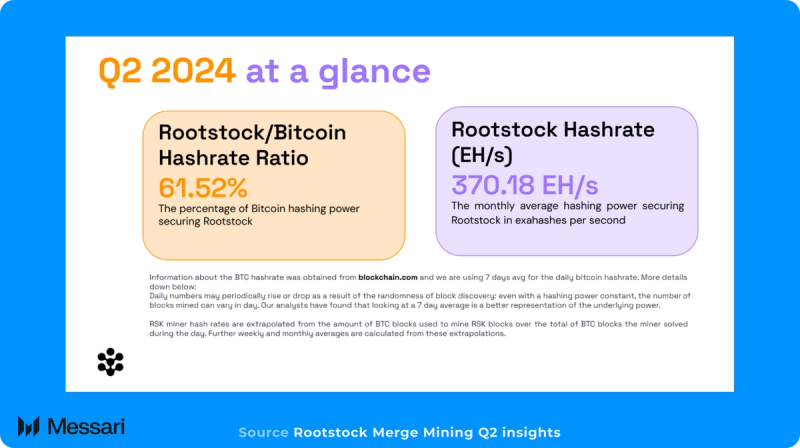
As of Q2, Rootstock has experienced major success in its merged mining. Entering what it calls the “mature phase” merged mining, the hashrate is now at 61% (i.e., Rootstock has been able to secure a quarterly average of over 61% of the total Bitcoin hashrate). In essence, Bitcoin miners representing 61% of total Bitcoin mining power secure the Rootstock network using the same hardware and energy inputs. Major Bitcoin mining pools, such as Antpool, Luxor, Braiins, F2Pool, and Binance Pool, have adopted the merged mining setup, enhancing Rootstock's security alongside Bitcoin.
Rootstock miners receive rewards solely from transaction fees, as the network does not issue its own native currency. Transaction fees are allocated to the federation and miners to ensure continued network security, while 20% is dedicated to RootstockLabs to support the network’s ongoing maintenance and development.
Qualitative AnalysisIn April 2024, IOVLabs rebranded to Rootstock Labs, signaling a continued commitment to developing and supporting the Rootstock ecosystem. With a global team of 145 members, Rootstock Labs will focus on advancing the Rootstock blockchain, building tools to empower and reward Bitcoin builders through the RIF framework, and supporting developers with grants and educational initiatives. The rebranding emphasizes the team’s dedication to growing the Rootstock ecosystem and fostering a thriving community around Bitcoin-based decentralized applications.
In May 2024, RootstockLabs relaunched its Ambassador Program, aiming to expand its community from 20 ambassadors in 7 countries to an additional 15 ambassadors across 15 new countries by the end of the quarter. Ambassadors are rewarded for completing tasks such as hosting meetups, creating content, and participating in community events. The program offers ambassadors monetary compensation, exclusive event access, opportunities to network, and a chance to deepen their blockchain knowledge. High-achieving ambassadors are also recognized in the Rootstock Community Newsletter, which reaches over 20,000 people globally.
In May 2024, RootstockLabs sponsored the EasyA Hackathon at Consensus 2024 in Austin, TX, contributing $50,000 in prize money for developers building on the Rootstock network. The three-day event, featuring a $160,000 total prize pool, saw five winning projects launched on Rootstock, utilizing its DeFi and EVM-compatible capabilities. Five Rootstock projects were awarded prizes. The top prize of $25,000 was awarded to Tap2Pay, a project with the goal of modernizing contactless payments by enabling transactions without NFC technology. Tap2Pay’s solution focuses on transforming emerging economies where Bitcoin is sent via SMS and has potential use cases in the entertainment industry, allowing artists to airdrop NFTs to audiences through ultrasonic waves. The artist could emit a sound, which then could correspond with the live audience members' phones, airdropping them an NFT. Other notable winners include Lens for decentralized credit scoring and Risky Rodeo for BTC staking.
Closing SummaryQ2 marked a period of growth for the Rootstock ecosystem. While TVL and revenue did consolidate after the previous quarters' strong climb, ecosystem development remained positive. Partnerships with major protocols like Sushi likely contributed to the increase in onchain activity. As Rootstock strengthens its position as a Bitcoin sidechain and leverages its merged mining technology, it is well-positioned to onboard more users through its diverse DeFi protocols and stablecoins.
Rootstock is also among the earliest Bitcoin Layer 2 solutions, giving it a significant advantage. While other Bitcoin L2s in the market are still undergoing a maturity process, Rootstock has already completed this phase, allowing it to focus on expanding its ecosystem and driving adoption more efficiently.
Rootstock’s future success hinges on its ability to drive technological advancements and communicate the benefits to potential users. With the strong onboarding of DeFi protocols in Q2 and a growing DeFi space, Rootstock is poised for further growth, unlocking more of Bitcoin’s liquidity for its users.
- Home
- About Us
- Write For Us / Submit Content
- Advertising And Affiliates
- Feeds And Syndication
- Contact Us
- Login
- Privacy
All Rights Reserved. Copyright , Central Coast Communications, Inc.